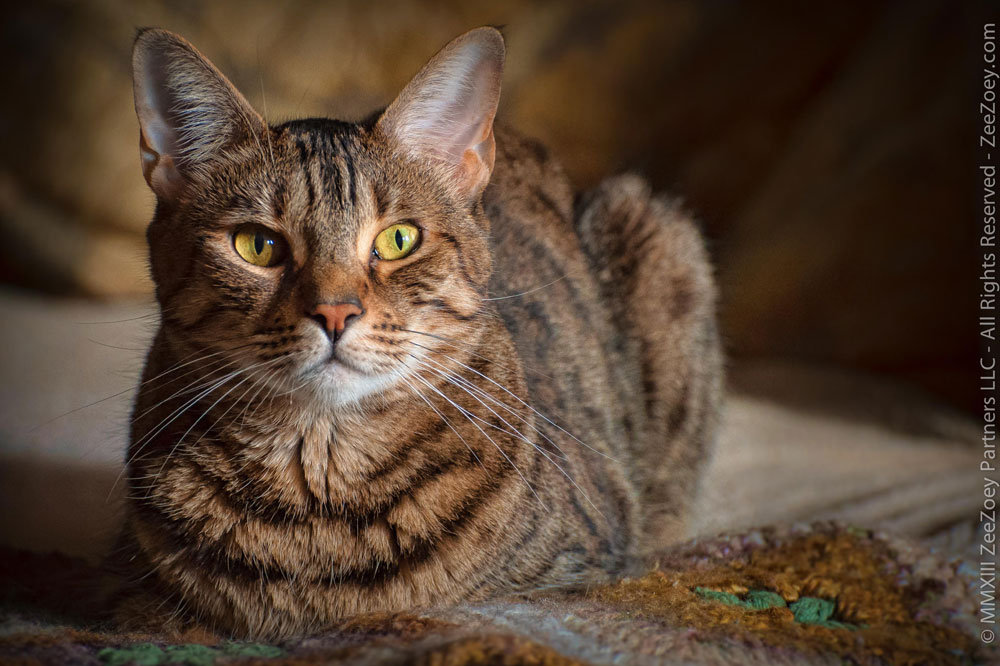Zee & Zoey’s Spay/Neuter Series – The Overall Health, Behavioral, and Emotional Benefits for Cats and Society at Large

Spaying your female cat, or neutering your male cat can significantly increase their lifespan by reducing certain health risks, infections, and cancers.
February is National Spay/Neuter Month and the importance of spay/neuter as a safe and humane means of preventing pregnancy and reducing cat overpopulation is being championed by cat advocates nationwide, and with good reason. According to the ASPCA, there are upward of 70 million homeless cats in the United States and approximately 5 to 7 million cats and dogs that enter shelters every year, with 70% of the cats needlessly euthanized because the number of these cats far exceeds the number of adopters. When you consider that cats can reproduce at an alarming rate – an unspayed/neutered cat pair can lead up to 5,000 cats in 7 years, it is quickly evident that spay/neuter is essential to ensure that these numbers will not continue to escalate.
But spay/neuter is so much more than a method of birth control – the overall health, emotional, and behavioral benefits to a cat from spay/neuter are significant and can actually result in less cats ending up on the streets and in shelters in the first place by having the procedure done. Negative behavioral issues that are typically the by-product of an unaltered cat (territory marking and spraying, aggressive fighting, loud yowling, and roaming) are often the reason a cat is brought to a shelter or dumped on the streets by a frustrated and desperate pet guardian.
These cats then become part of an ugly and tragic cycle – outdoor cats are persecuted by community citizens frustrated by the annoying behavioral problems they can exhibit and unfortunately, rather than embrace TNR (Trap, Neuter, Return) practices that can reduce these symptoms, often they are trapped and euthanized as the solution. Cats in shelters, older ones in particular that have not already been altered, may come with a host of behavioral problems that result in them being overlooked for adoptions, or worse, tragically euthanized.

Zee is an absolute sweetheart with a wonderful temperament This was not the case prior to his neuter – he was aggressive with the other household cats, moody, and marked the furniture with his urine spray.
When it comes to a pet in our home, these symptoms can cause a myriad of problems – stress on personal relationships when perhaps one partner wants to keep the cat, the other wants to get rid of it, stress with other pets if you live in a multi-pet household who are bothered by the erratic behavior of the unaltered cat, irrevocable damage to furniture and walls from urine marking, and even an unintentional resentment of a beloved pet because it is now so difficult to be around and not what you bargained for when you first adopted it. All of these behavioral problems can be virtually eliminated with early spay/neuter (a “pre-pubertal” spay/neuter is now recommended by veterinarians and is safe with kittens as soon as they weigh at least 2 pounds, which is ideally between 8 and 12 weeks) and the truth is, until your cat is altered, it is instinctual for them to try to find a mate and most attempts at training, bribing with treats, or scolding to change the negative behavior are for naught.
Until a female is spayed, she will typically go into heat four to five days every three weeks during breeding season which is based on daylight hours. Calling for her mate, she will loudly vocalize through the duration of her heat and will urinate more frequently, often uncontrollably, throughout the house. She can be emotional, uncomfortable, and just generally difficult to be around. Her heat cycle is based on a hormone called melatonin, which is secreted by a gland in her brain. This hormone decreases with the arrival of more daylight, which triggers the heat cycle.

Mia is a sweet and happy cat thanks to her spay a couple years ago. Prior to that, her heat cycle was so extreme she barely ate, she peed all over the house, yowled constantly, and you could not even pet her she was so agitated.
Because it is not unusual for an indoor cat to be exposed to artificial light year-round, she may experience almost constant hormonal activity and many more periods of heat. Since a kitten can go into heat as early as 4 months, it is just best to have her spayed at a young age. It is not necessary for her to experience her first heat before you spay her and she will be much happier and healthier in the long run for having the procedure done.
An unaltered male cat can demonstrate equally detrimental behavioral habits that are all but impossible to correct if he is not neutered at a young age. He can be extremely aggressive and territorial, marking the house by spraying walls and furniture with strong smelling urine. By having him neutered, not only will these tendencies be greatly reduced or eliminated, he will also be less likely to want to roam, which might result in an injury to him in traffic, a fatality, or finding a fertile female to impregnate.

We got Rolz neutered at 7 months and have never experienced any negative behavior from him – no spraying and fighting – only a very happy and well adjusted kitty!
The other significant benefit of spay/neuter is that it greatly improves the health and longevity of a cat’s life. Spaying a female prior to her first heat nearly eliminates the risk of mammary cancer, uterine infections, and uterine cancer, which is fatal to approximately 90% of cats according to the American Humane Association, and neutering a male before he is 6 months of age prevents testicular and prostate cancer. No one wants to see a beloved pet suffer these tragic types of illnesses, so having the procedure done is the best gift you can give your cat.
Clearly the benefits of spay/neuter are significant and far reaching – from reducing cat overpopulation to ensuring your cat has a happier and healthier life. But having a happy and healthy cat also benefits society at large. Studies have proven that our feline friends improve the quality of our human lives. A cat can decrease our depression, stress and anxiety. They can also lower our blood pressure and decrease the risk of heart attack and stroke. They are used in rehabilitation facilities, senior citizen homes, hospitals, and even to help returning soldiers to deal with post-traumatic stress disorder. Having a pet cat in a family with children helps in their emotional development and encourages responsibility and compassion.

Having a cat as part of a family can bring untold love and companionship. It can also encourage responsibility and compassion, as well as health and emotional benefits. Photo credit: Deposit photos.
Proper diet, veterinary care, exercise, stimulating toys, scratching posts, comfortable bedding, and a clean litter box are all important to the well-being of our cat. By adding spay/neuter to the list, we are ensuring that our cat will live a long, happy, healthy life.
For further information on spay/neuter, cat overpopulation, and more cat facts, please reference these detailed articles:
Zee & Zoey’s Spay/Neuter Series – The Facts of Life: The 101’s of Kittens and Conception
Zee & Zoey’s Spay/Neuter Series – Cat Overpopulation and the Moral Ethics of Time
Zee & Zoey’s Spay/Neuter Series – Making Sense of Cat Overpopulation When the Numbers Don’t Add Up
























Deb,
Great article. Very informative and should compel people to spay or neuter their pets.
The 2 shelters in my town, now spay or neuter everyone that comes in.
It’s too bad your cats were so misbehaved for you. I’m glad they all came around
after the neutering was done.
Thank you Connie – I’m glad your shelter spays and neuters the kitties. As far as mine, the behavioral issues were only temporary, so all is good now!
Your series is wonderful. There are so many who need to be educated on the benefits of spay/neutering and your blog posts will be valuable resources forever!
Thank you Caren – I appreciate your kind words and truly hope that I am able to help make a difference in regards to educating people. I’m sure most people are aware of bits and pieces of what spay/neuter is about, so that is why I wanted to offer a fully comprehensive series that ties everything together to fill in any gaps people might have.
Another excellent post and I agree with it 100 percent!
Thank you Mariodacat!
In four days, Valentine’s Day, our cats–who are just under 6 months–will be spayed. Thanks for this post.
Michele – that is the greatest gift you could ever give your kittens – what a loving and life changing gift! 🙂
you are looking FABulous as ever harley; you also zee, mia & rolz…..thanx for posting this article….my poor mom had two litters by the age of 6 months….??????
I was spayed at 12 weeks and even though the boys will tell you different; there’s absolutely nothing wrong with me ….even if there… was they better not say so
hugs from dai$y, queen of cats; royalty of trout towne =^..*=
da tabbies – sometimes unplanned litters happen and the only thing we can do is try to make the best of it and learn from it. That’s why these posts are so important to me – not everyone knows how important spay/neuter is and we all can learn from one another. xoxox
Important life saving info for kitties. Thanks for posting
Thank you Linda – I appreciate your support.
Great post. Thanks for talking about it. All my furbabies are neutered.
You are very welcome, Sue. Glad I can help inform people as best I can!
Thanks for continuing to provide well-written information on this very important topic. Purrs and hugs from the kitties at http://www.thecatonmyhead.com, Lily Olivia, Mauricio, Misty May, Giulietta, Fiona, Astrid, Lisbeth and Calista Josette
You are welcome Janet. I hope they are helping to make a difference for kitties in some small way…
Spaying and neutering is soooooo important. Kittens can be spayed an neutered very young and be just fine. A vet friend of mine used to spay kittens from the shelter really early since he knew that the people wouldn’t bring them back so he made sure they got done. It is one of my favorite subjects.
I could not agree more, Marg. I don’t know if you got to read the post I did last week on kittens and conception, but it is such an important message to share. https://zeezoey.com/blog/zee-zoeys-spayneuter-series-part-one-the-facts-of-life-the-101s-of-kittens-and-conception/
Again, very informative article. My female kitty started to show disruptive behavior, crying all the time, wanting to be let out (she is an indoor cat). Being new to cats at the time, I did not know this was because of the mating season. I figured this out after searching for it on the internet. Once, I realized that this was the case, we had her spayed and the disruptive behavior did not happen again (unless she wants something of course). It’s great that this information is laid out and relates to your experiences, so people know that others go through this and that there is a solution other than abandoning or giving up their kitty.
—–
Cindy
Chief Editor
Universal Cats
Cindy – this is the best compliment I could ever get. I try very hard to keep my posts real. I think that is why they resonate so well with people, because I am speaking from experience, flaws and all. I try to be honest, informative, and helpful. Thank you again and I am glad you had your sweetheart spayed early so you did not have to deal with her disruptive behavior for too long!! I know my Mia was an absolute nightmare to be around until she was spayed!!
I am definitely passing it on and urging people to read it. The more education that is out there, the more people will realize that they can make a huge difference in helping overcrowded shelters just by one simple decision. Some say “oh I won’t turn my kittens in to the shelters , I will find them all great homes” well that is great but what about those kittens that went in to that great home? Are they getting spayed or neutered? Are they contributing to the problem?
Love your blog!
Thank you so much, Carma Poodale. I must admit you have me a bit chocked up at the moment. When I read comments like yours, it really makes the effort of writing so worth it and I truly feel we can make a difference banding together to spread the message and educate people.
We are 100% in agreement, Deb! Your excellent article should be required reading for cat owners!
Hmmm…. I like that idea very much…. you’ve given me something to ponder, meowmeowmans!!
Excellent post Deb. I have had cats my whole life and they all have been spayed or neutered. When I was growing up, the vets told us we had to wait for 6 months of age or the first heat cycle. I have found those cats who get it done younger ar so much better behaved.
Nellie’s Mom
Terrific information that many people are not aware of – it’s not just that spay/neuter helps prevent unwanted babies, it’s also beneficial to your cat’s overall health and well-being. One more reason to spay/neuter!
Thank you for blogging the change for animals,
Kim Thomas
btc4animals.com
cindylusmuse.blogspot.com
I was hoping I’d find you had mentioned the health problems – specifically mammary cancer and the other cancer risks – associated with NOT spaying. You did not disappoint! It is so critical to the health of our pets to spay and neuter. Thanks again for another great article.